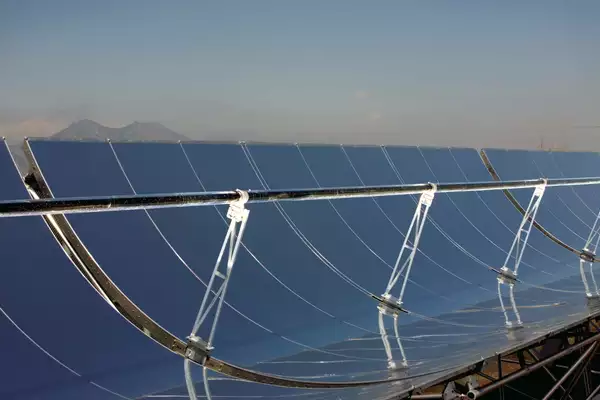Solar paraboloid technology is gaining attention as a promising solution to enhance the efficiency of solar energy capture and contribute to global net-zero targets.
About Solar Paraboloid Technology
- Parabolic Trough Collector (PTC): Utilizes long, parabolic mirrors to concentrate sunlight onto a receiver tube placed at the mirror’s focal line.
- Energy Capture: The concentrated sunlight heats a fluid in the receiver tube, which is then used to generate electricity or provide heat for industrial processes.
Advantages Over Traditional PV Systems:
- Higher Operating Temperatures: Can operate up to 300°C, enhancing thermal efficiency.
- Reduced Heat Losses: Smaller absorbing surface area minimizes convective and conductive heat losses, leading to increased efficiency.
- Future Vision: By 2050, solar paraboloids could achieve cost parity, scale up deployment, and play a critical role in achieving net-zero emissions.
- Economic Benefits:
- Increased Efficiency: More electricity generated from the same amount of sunlight.
- Cost Competitiveness: Potential to lower costs per unit of electricity produced, making solar energy more competitive with fossil fuels.
Challenges:
- High Upfront Costs: Precise construction, specialized materials, and complex tracking systems contribute to higher initial investments.
- Infrastructure Requirements: Need for significant infrastructure and maintenance.
Ref: Source
| UPSC IAS Preparation Resources | |
| Current Affairs Analysis | Topperspedia |
| GS Shots | Simply Explained |
| Daily Flash Cards | Daily Quiz |
Frequently Asked Question:
How does a Parabolic Trough Collector work in solar paraboloid technology?
A Parabolic Trough Collector uses long, parabolic mirrors to concentrate sunlight onto a receiver tube, which heats a fluid to generate electricity or provide heat for industrial processes.
What advantage does solar paraboloid technology have over traditional PV systems?
Solar paraboloid technology can operate at higher temperatures, up to 300°C, increasing thermal efficiency due to reduced heat losses from a smaller absorbing surface area.
What is the future vision for solar paraboloid technology by 2050?
By 2050, solar paraboloids aim to achieve cost parity with traditional energy sources, scale up deployment, and play a critical role in achieving net-zero emissions globally.
How do reduced heat losses in solar paraboloid technology contribute to efficiency?
Smaller absorbing surface areas in solar paraboloid technology minimize convective and conductive heat losses, leading to increased overall efficiency in capturing and utilizing solar energy.
What are the economic benefits of implementing solar paraboloid technology?
Solar paraboloid technology offers economic benefits through increased energy efficiency, reduced operating costs, and potential cost parity with traditional energy sources, supporting global efforts towards achieving net-zero.




